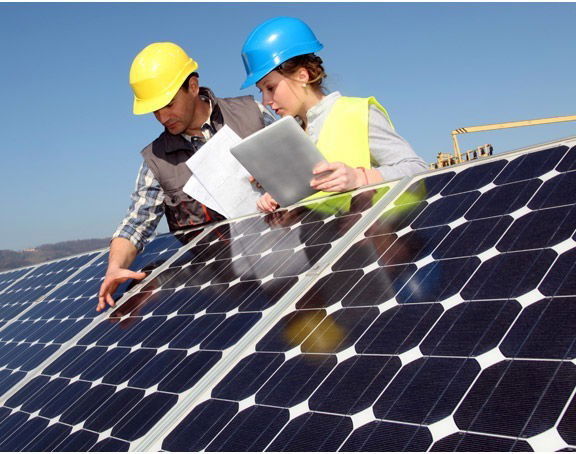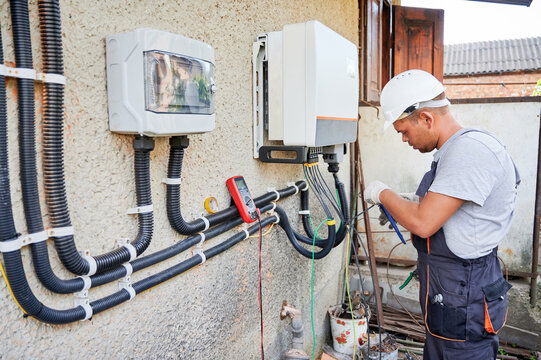
Solar power is a fantastic renewable energy solution, but like any technology, solar inverters can encounter problems over time. A solar inverter is crucial in converting the direct current (DC) generated by solar panels into alternating current (AC), which is used in your home or business. When the inverter fails, the entire system suffers, leading to reduced efficiency and potential downtime. In this post, we’ll explore some common issues solar inverters face and provide guidance on how to fix or troubleshoot them. Whether you're a homeowner with a solar system or a professional installer, this knowledge can help you keep your system running efficiently.
1. Inverter Not Turning On
Problem: One of the most basic issues you may encounter is when the inverter doesn't turn on. This could be caused by various factors, such as a power issue, a fault in the inverter, or problems with the system’s wiring.
Possible Causes:
- Power Supply Issues: If there’s a power interruption or if the circuit breaker has tripped, the inverter may fail to start.
- Faulty Wiring: Loose or damaged connections between the inverter and the solar panels can prevent the inverter from turning on.
Fix:
- Check the circuit breaker: Make sure the breaker connected to the inverter is not tripped. If it is, reset it.
- Inspect the power supply: Verify that there is an adequate power supply to the inverter, and that the inverter's AC and DC inputs are functional.
- Check the connections: Ensure all the wires are connected correctly and securely. If any wires are loose or damaged, repair or replace them.

2. Inverter Showing Error Messages
Problem: Solar inverters are designed to display error codes when they encounter a fault. These error messages could indicate issues with system performance or safety concerns.
Possible Causes:
- Overheating: If the inverter is exposed to excessive heat, it might display an error code.
- Grid Connection Issues: Problems with the grid connection, like voltage fluctuations or power surges, can trigger error codes.
- Internal Faults: Hardware issues inside the inverter may cause it to malfunction.
Fix:
- Check for overheating: Ensure that the inverter is installed in a well-ventilated area, away from direct sunlight or sources of heat. If the inverter feels hot, let it cool down before attempting to reset it.
- Reset the inverter: Follow the manufacturer’s instructions to reset the inverter and clear any temporary errors.
- Check grid voltage: Use a multimeter to check the grid voltage. If it's outside the recommended range, contact your utility provider.
3. Inverter is Displaying Low or No Power Output
Problem: One of the most frustrating issues is when the inverter is running but not producing the expected power output.
Possible Causes:
- Shading on Solar Panels: Even partial shading of solar panels can lead to significant power loss.
- Dirty Solar Panels: Dust, dirt, or debris on the panels can block sunlight and reduce efficiency.
- Panel Connection Issues: If the solar panels are not properly connected or if there are faulty connections, power output will be affected.
- Inverter Overload: The inverter may be overloaded if there are more connected devices than it can handle.
Fix:
- Clean your solar panels: Regularly clean your panels to ensure they are free of dirt, dust, and debris. Be sure to use non-abrasive cleaning materials.
- Inspect panel alignment and orientation: Check if the solar panels are properly oriented to maximize sunlight exposure. Ensure no nearby objects are causing shading.
- Examine panel connections: Inspect all the connections between the panels and the inverter to make sure they are secure.
- Reduce load: If the inverter is overloaded, disconnect some devices to prevent damage and improve performance.
4. Inverter Displaying ‘Ground Fault’ or ‘Arc Fault’
Problem: Ground faults and arc faults are serious issues that can compromise the safety of your solar system. A ground fault happens when the electrical current inadvertently connects with the ground, while an arc fault occurs when there's an electrical discharge between conductors.
Possible Causes:
- Damaged Wiring: Worn or damaged wires can cause ground or arc faults.
- Faulty Connections: Loose or faulty connections between the inverter and the solar panels can trigger these faults.
- Water Damage: Exposure to moisture can lead to short circuits or faults in the system.
Fix:
- Inspect all wiring: Check the wiring for visible damage or wear and tear. Replace any damaged wires.
- Examine connections: Ensure all connections are tight and secure, particularly around the inverter, solar panels, and junction boxes.
- Waterproofing: Ensure that the inverter and all electrical connections are properly sealed and protected from moisture.
5. Inverter is Making Unusual Noises
Problem: Inverters may emit sounds like buzzing or clicking during normal operation. However, if the noise becomes loud, continuous, or irregular, it could be an indication of a malfunction.
Possible Causes:
- Fan Issues: Some inverters have internal cooling fans that can get noisy if they become clogged with dust or fail.
- Electrical Arcing: An electrical arc or fault inside the inverter can cause a buzzing or crackling noise.
- Loose Components: Components inside the inverter may become loose or vibrate, creating unwanted sounds.
Fix:
- Check the fan: If the noise is coming from the fan, clean it out using compressed air or a soft brush to remove any dust or debris.
- Examine the inverter for loose parts: Tighten any loose screws or components inside the inverter. If you notice any damaged parts, consult a professional technician for repairs.
- Contact support for internal faults: If the noise persists, it could indicate an internal electrical fault, and the inverter may need to be inspected by a professional.
6. Inverter Not Syncing with the Grid
Problem: If the inverter is unable to sync with the utility grid, it can result in an inability to feed power back into the grid or cause system shutdowns.
Possible Causes:
- Grid Voltage Instability: Fluctuating grid voltage or surges can cause synchronization issues.
- Inverter Settings: The inverter may not be correctly configured to match the grid frequency and voltage.
- Internal Inverter Faults: A malfunctioning inverter could fail to detect grid conditions correctly.
Fix:
- Check grid voltage: Ensure that the grid voltage is stable and within the specifications of your inverter. You can do this with a voltmeter.
- Verify inverter settings: Double-check the inverter’s settings to ensure they are compatible with your local grid parameters.
- Consult a technician: If issues persist, you may need a professional to diagnose and resolve any internal faults with the inverter.
Final Thoughts
Solar inverters are complex devices that can experience a variety of issues, from simple wiring problems to more complicated internal faults. Understanding common issues and their fixes can save you time and money, allowing you to maintain your solar system efficiently. If you're unsure about any of these fixes or if the problem persists after troubleshooting, it's always best to contact a certified solar technician. Regular maintenance, such as cleaning your panels, checking for wiring issues, and keeping the inverter well-ventilated, can also go a long way in extending the life and performance of your solar system. By staying on top of potential issues and addressing them early, you can ensure your solar system continues to deliver clean, renewable energy for years to come.